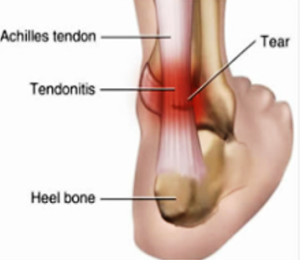Achilles Tendon Pain
Achilles Tendon Pain/Tendonitis
The Achilles tendon is the largest and strongest tendon in the body. It connects the 2 large calf muscles (the gastrocnemius and soleus) to the back of the heel bone (calcaneus). The tendon gives us the ability to rise up onto our toes and is very important in facilitating walking and running. Forces up to 12 times body weight may arise during sporting activities.
Achilles pain is usually a result of tendinitis caused by tight or fatigued calf muscles which transfer too much of the burden of walking or running to the Achilles tendon. The tendon becomes inflamed and over time can produce a covering of scar tissue which is less flexible than the tendon. Achilles tendinopathy can vary in severity from a mild pain during an activity to more severe cases of tears or even rupture.
Cause
Achilles tendonitis is most commonly related to overuse and continues stress of the tendon.
- Not stretching the calves properly
- Excessive hill running, sand running or speed work, all of which stress the Achilles more than other types of running, can bring on Achilles tendinitis.
- People who over-pronate (their feet roll too far inward on impact) are most susceptible to Achilles tendinitis
Symptoms
Symptoms usually include;
- Pain that can be a dull or sharp anywhere along the back of the tendon worse after rest or excessive activity.
- A nodule of scar tissue can often be felt on the tendon.
- Local swelling and redness can occur about 2-3cm above the heel bone.
- Often there is also limited ankle flexibility.
- Onset of pain when increasing mileage whilst running.
Treatment
Early treatment of Achilles Tendonitis is essential to develop an affective treatment program. It is important to ensure the Achilles Tendon is pain free and then ease back into any running or walking program.
- To help prevent Achilles tendinitis stretching the calf muscles is important. Wearing the right shoes, strapping and strengthening exercises are critical.
- Rest and Ice – 20 min every two to three hours advised in the first 48-72 hours of the injury taking place
- Non-steroidal anti-inflammatory medication (NSAIDs) – help reduce the pain and inflammation
- Exercise program – exercises, stretching and rehabilitation may be prescribed to help improve range of motion and stabilise the foot and ankle.
- Custom made orthotic therapy – orthotics may be prescribed to address any biomechanical factors to reduce the stress on the Achilles Tendon.
- Dry Needling.
- Prolotherapy- for chronic Achilles pain, Prolotherapy may be performed providing pain relief, and improving healing of the tendon.
- In severe cases, referral for surgical treatment may be required.
REMEMBER ACHILLES TENDINITIS CAN LEAD TO TEAR AND RUPTURE. IF IN DOUBT REST AND GET A MEDICAL PROFESSIONAL OPINION

